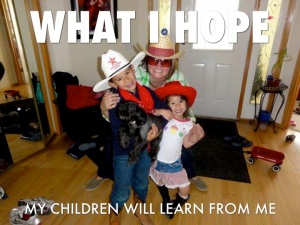Tag Archives: vlog
Teens are Natural Learners if we Let Them Fly
Loved this Ted Talk about the positive things teens are doing online. Adults need to *learn* to be connected educators, but many teens do it naturally. Love to hear about these ripples….
Summer is a great time for reflection
This week I had a lot of fun tinkering around online, thanks for the great ideas Open Spokes. I was trying out new ideas while reflecting on what I want to teach my kids.
I started out playing with the new haiku deck app… see the following link,
http://www.haikudeck.com/p/mQBhZc6BTC/what-i-hope-my-children-will-learn-from-me

I was then able to import my haiku deck into a powerpoint.
From here I was able to import the power point into imovie.
I added some creative commons musics using the site http://www.jamendo.com/
And my final product turned out like this:
Connecting the World’s Classrooms Through Online Collaboration
One of the things that I love most about #Etmooc (yes, I know it’s been three months but I’m still singing its praises) was the way it encouraged all of us to become reflective practitioners and life long learners.
I try to think: What I’m currently doing in my classroom might already be working well- but we need to be constantly playing around to find ways to make it better and more relevant to my students http://www.hybridpedagogy.com/Journal/files/Letter_from_a_Hybrid_Student.html
In the spirit of lifelong learning and collaboration a number of us have come together to form a post #etmooc reading group which chooses monthly themes and topics to read, reflect and discuss. Over the past month we’ve been contemplating 21st century publishing at all grade levels. It sometimes amazes me how much educators from the wide of a range have in common, as well as some of the differences in openness and access each age group must account for when they plan their lessons and student learning assignments.
This morning I was fortunate to be able to participate in the post #etmooc group hangout (which I must thank Rhonda Jessen @rljessen for moderating).
I loved this meeting as it involved educators from elementary all the way up to post secondary- as well as a few members of the HYBRID PEDAGOGY digital journal team, Jesse Strommel and Sean Morris. If you are not familiar with the HYBRID PEDAGOGY digital journal, I would highly recommend checking out the link below. http://www.hybridpedagogy.com/Journal/files/CFP_K12_Dialogue.html
As well, if you have a topic you are passionate about related to educational pedagogy I would recommend you submit an article to the publication. This team is willing to review any article, whether from elementary, secondary or post -secondary, and work with the author until you have developed a publishable piece of work.
Next month I will be leaving for a one year contract in Japan. The purpose of my position is to liaise between the Calgary and Japanese school boards. I am hoping that one of the ways that I can facilitate this is through collaborative projects between my Japanese and Canadian students.

One of the things that I appreciate most about my #etmooc pln is the safety I feel in being able to ask for help and suggestions. Since I had access to amazing minds spanning from many backgrounds and areas I decided to ask the group if they had any suggestions. I received the following ideas which I will try to explore over the next few months:
1) Using Google docs
http://www.hybridpedagogy.com/Journal/files/10_Tips_for_Google_Docs.html
Some of the benefits of google docs are that they allow for asynchronous collaboration from a variety of sites. As well, if given the link, students can contribute to the document without having to register as a google member.
2) Etherpad
This program is similar to a Google Doc. Etherpad allows you to edit documents collaboratively in real-time, much like a live multi-player editor that runs in your browser. Studnets can write articles with peers from around the world, all working on the same document at the same time.
3) Draft
https://draftin.com/
When using Google Doc, collaborators overwrite the master copy. However, when you share your document using Draft, any changes your collaborator makes are on their own copy of the document, and you get to accept or ignore each individual change they make.
4) Blogging
There are a variety of servers which can be used for blogging.
http://kidblog.org/home/
Kidblog provides teachers with the tools to help students safely navigate the digital – and increasingly social – online landscape. Kidblog allows students to exercise digital citizenship within a secure, private classroom blogging space. All blog are private only to the class by default, teachers can then choose which items can be shared publically.
Edublogs lets you easily create & manage student & teacher blogs, quickly customize designs and include videos, photos & podcasts. This account appears to be easier to use than word press.
Once you register for an edublog account teachers can create a class and monitor/moderate all content, forums and threaded discussions, Wikis, ePortfolios, and more
http://wordpress.com/
The blog site that I am currently using, it is not overly secure for classroom use, however I am planning to have my son blog about our experience in Japan to practice his English writing while we are away. He’ll be in grade 3 next year and would love to share his work with others. Check him out at http://erinluong21.wordpress.com/
5) Skype
https://login.skype.com/login
Skype; is a popular, easy to use and reliable (Voice over Internet Protocol) program, that allows you call and talk to other Skype users, video chat; and more for free over the internet. Skype supports conference calls up to 25 people at a time. Skype also supports video chat between two people for free. Screen sharing and group video calling is available for Premium subscribers between a maximum of 10 people. http://en.wikipedia.org/wiki/Skype
As I am open to collaboration and connecting with colleagues from around the worId I may also want to look into applying for a flat classroom, collaborative project for next year. http://flatclassroomproject.ning.com/
I am so excited about being able to experiment and play.
If you have any others suggestions or words of wisdom around student collaboration feel free to drop me a line and share.
Sayonara for now
Behavior is Language
Friends, family and teachers make excellent referrals to school counsellors.
Am I looking for students to experience “Failure” or to realize that somethings are worth working for?
Today I read the following excellent blog post WHERE DOES FAILURE FIT http://somewherefromhere.edublogs.org/2013/05/28/finding-the-freedom-of-failure/#.Ua35T5GtC1g.twitter
After reading Kirsten’s thoughts I began to wonder? “Am I looking for students to experience “Failure” or to realize that somethings are worth working for?”
I decided that the next thing I need to do was reframe my perception of failure, and to do so I should look up a few synonyms.
DISAPPOINTMENT
LET DOWN
When I looked up the synonyms for failure the following statements popped up in my minds eye.
It’s not the end of the world?
Try going on another path?
How can we encourage students to find those other paths?
Tony Wagner suggests the following 7 survival skills http://www.tonywagner.com/7-survival-skills
• Critical thinking and problem-solving
• Collaboration across networks and leading by influence
• Agility and adaptability
• Initiative and entrepreneurialism
• Effective oral and written communication
• Accessing and analyzing information
• Curiosity and imagination
I would suggest promoting RESILIENCY
What makes me tick- my teaching philosophy
Safe to Share
How my rugby coaching will help my future students
Hey Etmooc….I’m joining a fellowship
Check this out
I can’t wait to be Ms. Thursday
Feel free to join us if you are interested
